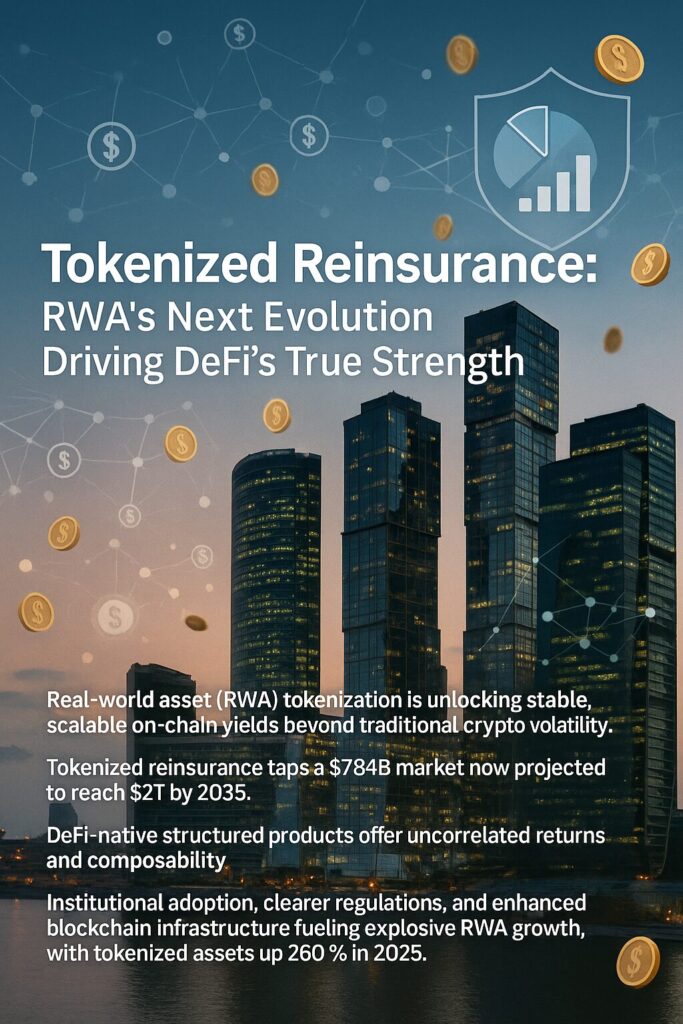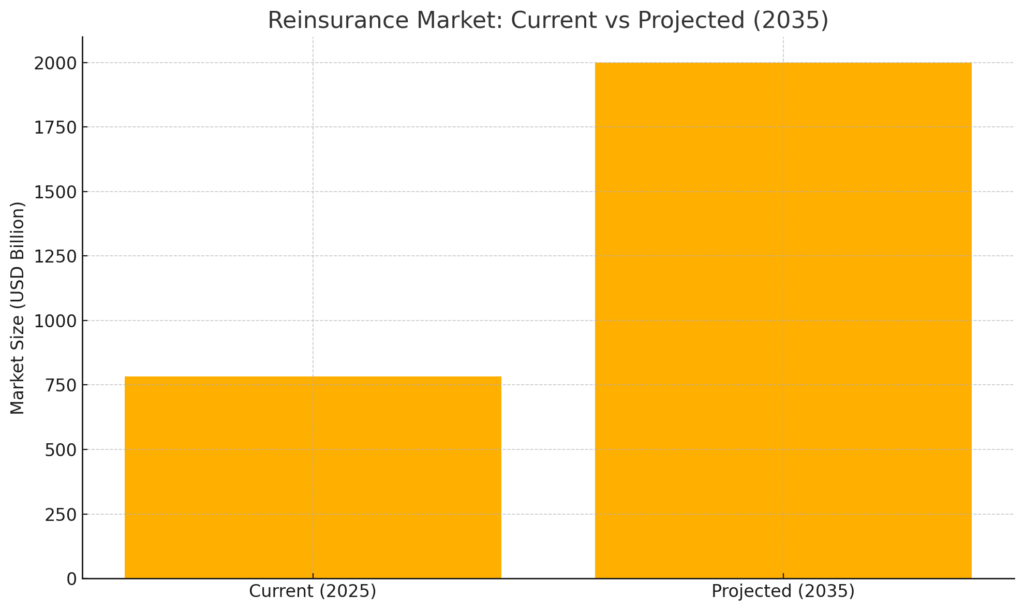
Main Points:
- Real-world asset (RWA) tokenization is unlocking stable, scalable on-chain yields beyond traditional crypto volatility.
- Tokenized reinsurance taps a $784 billion market now projected to reach $2 trillion by 2035.
- DeFi-native structured products—like pairing Ethena’s sUSDe with reinsurance risk pools—offer uncorrelated returns and composability.
- Institutional adoption, clearer regulations, and enhanced blockchain infrastructure are fueling explosive RWA growth, with tokenized assets up 260 % in 2025.
- On-chain RWA market value surpassed $24.3 billion in mid-2025, reflecting broadening acceptance by major players.
1. Introduction: The New Bedrock of Crypto
Over the past decade, cryptocurrency strategies have chased high-volatility returns—from BTC’s dramatic bull runs to DeFi yield farms. Yet the quest for dependable on-chain yield has never been more urgent. In this context, tokenized real-world assets (RWAs) have emerged as a cornerstone of digital-asset portfolios, marrying the stability of traditional finance (TradFi) with blockchain’s transparency and composability. Initially centered on tokenized U.S. Treasuries and private-credit instruments, the RWA narrative is rapidly evolving. Now, tokenized reinsurance represents the next frontier—delivering unique risk-return profiles, modular DeFi integration, and access to vast, previously inaccessible markets.

2. The Rise of Tokenized Reinsurance
2.1 What Is Reinsurance?
Reinsurance is a form of structured finance in which insurers transfer portions of their risk portfolios to other parties to manage large or unexpected losses. This multi-trillion-dollar market has traditionally been opaque and reserved for major institutions, hindered by outdated infrastructure and high entry barriers.
2.2 Market Size and Growth
Today’s global reinsurance market stands at roughly $784 billion—and is forecast to grow to $2 trillion by 2035, fueled by rising insurance premiums and expanding catastrophe coverage needs. See Chart below for market size comparison.
3.2 Uncorrelated, Resilient Returns
Unlike pure crypto-asset strategies, these hybrid products deliver returns driven by insurance underwriting rather than crypto-market sentiment—fortifying portfolios against volatility and delivering a diversifier that is uncorrelated with BTC, ETH, or altcoin cycles.
4. Broader RWA Tokenization Trends
4.1 Institutional Adoption & BlackRock’s BUIDL
Institutional giants are staking early claims in RWA tokenization. BlackRock’s BUIDL tokenized U.S. Treasury fund skyrocketed from $649 million to $2.9 billion within 2025—a 350 % jump—illustrating deepening integration of RWAs into DeFi.
4.2 Regulatory Clarity and Infrastructure
Regulators in multiple jurisdictions are laying foundational frameworks to govern digital-asset securities and tokenized instruments. Meanwhile, protocols like Securitize are delivering turnkey issuance, compliance, and secondary-market trading platforms—bridging TradFi and DeFi with audited smart contracts and automated KYC/AML.
4.3 Market Expansion & Liquidity
As of mid-2025, total on-chain RWA market capitalization eclipsed $24.31 billion, a testament to accelerating token issuance across Treasuries, private credit, real estate, commodities, and now, reinsurance.
5. Technological and Ecosystem Enablers
- Enhanced Blockchain Infrastructure: Layer-1s and Rollups (e.g., Arbitrum, Optimism) now offer high-throughput, low-cost environments essential for high-volume RWA transactions.
- Oracles and Data Feeds: Secure pipelines from real-world data providers ensure accurate premiums, loss events, and NAV calculations on-chain.
- Smart-Contract Composability: Modular DeFi primitives allow RWA tokens to plug into lending markets, automated market makers, and yield-aggregation protocols.
- Cross-Chain Bridges: Interoperability solutions extend RWA tokens across ecosystems, boosting liquidity and enabling multi-chain strategies.
6. Future Outlook
Tokenized reinsurance exemplifies RWA’s trajectory: moving from elementary tokenization of bond-like assets toward entirely new, crypto-native financial structures. In the next wave:
- Parametric and Collaborative Insurance: Automated, data-triggered payouts will reduce settlement friction and foster community-driven underwriting pools.
- Risk Tranching & NFTs: Fractionalized claims could be packaged into risk-adjusted tranches, with NFTs representing discrete risk slices.
- AI-Driven Pricing & Underwriting: Machine learning models on-chain will refine premium pricing and capital allocation in real time.
Conclusion
Tokenized reinsurance stands at the confluence of structured finance innovation and DeFi’s composability, unlocking a vast market once restricted to opaque TradFi corridors. By harnessing blockchain’s transparency, modularity, and global accessibility, crypto investors can now access stable, uncorrelated yields that enrich portfolio resilience. As institutional adoption and regulatory clarity mature, RWA tokenization—anchored by pioneering reinsurance use cases—will likely define the next era of digital-asset growth, bridging the long-standing gap between the on-chain and off-chain worlds.

